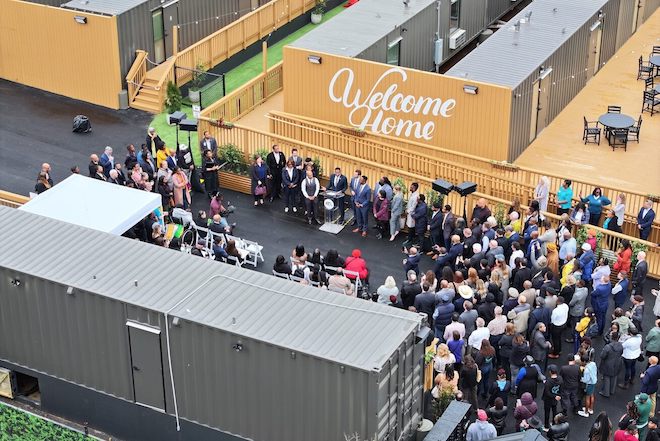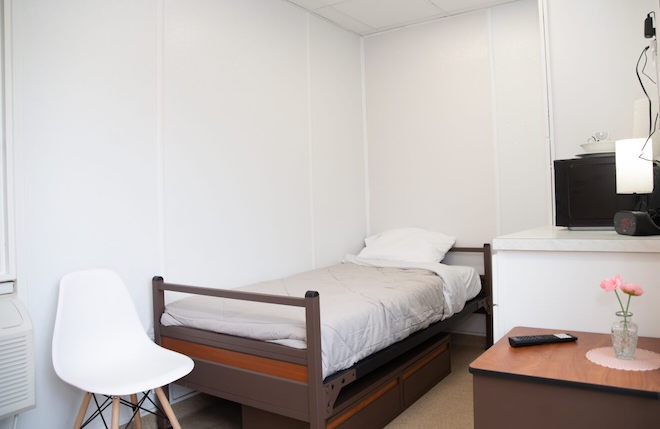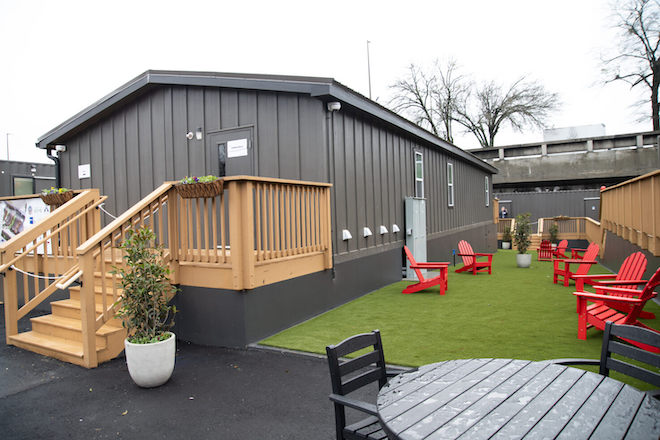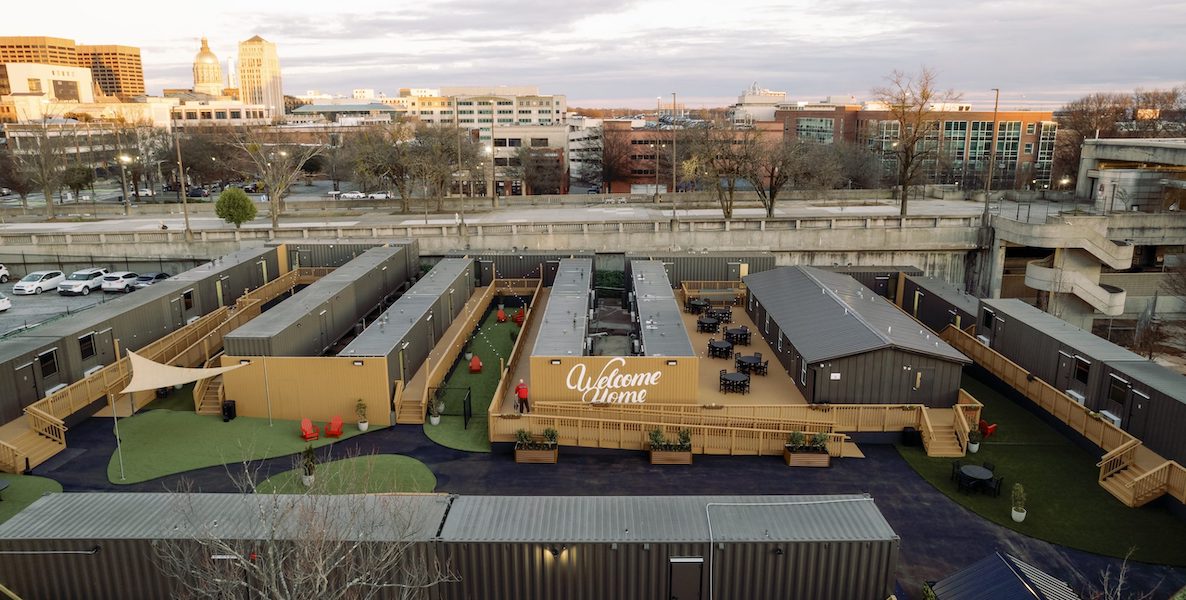The Melody, a housing development in Downtown Atlanta, looks from the outside like a typical, modern housing development. There’s a dog park and patio with chairs where residents can gather. The development has its name and the phrase “Welcome Home” in cursive by the entrance.
What makes this particular development unique is not just that it was the fastest built affordable housing project in Georgia history. All 40 units were constructed in four months — from old shipping containers.
The development is part of a city project aimed at fighting homelessness by giving people places to live and offering them the wraparound services they need to find more stable housing options.

“We had people who just days before were sleeping under bridges in downtown Atlanta who were now sleeping in their own housing unit,” says Joshua Humphries, senior housing advisor to Atlanta Mayor Andre Dickens.
The Melody opened last year, but already other cities are looking to build their own shipping container villages to combat homelessness. In Philly, Mayor Cherelle Parker has laid out ambitious, affordable housing goals, similar to the ones that helped make this development possible in Atlanta. Could — and should — Philadelphia build temporary housing from shipping containers too?
Why shipping containers?
A few factors converged to help make The Melody possible. Mayor Dickens set a goal three years ago of building 20,000 affordable housing units. So far, Atlanta has completed 6,500 units and another 4,500 are under construction, but they wanted to be able to build units faster to help people experiencing homelessness in Atlanta. It can take three to five years to build a typical housing development, Humphries says.
“We’ve got residents in the city that are living on the streets. They can’t afford to wait the three to four years it takes to build new housing,” Humphries says. “We realized we needed to move even faster to build supportive housing opportunities for our residents experiencing homelessness.”
When Georgia Emergency Management Agency (GEMA) offered the City shipping containers they’d repurposed into makeshift hospitals in 2020 during the height of the pandemic, it seemed like a perfect way to quickly create low-cost, micro housing units.
“We had people who just days before were sleeping under bridges in downtown Atlanta who were now sleeping in their own housing unit.” — Joshua Humphries, City of Atlanta
The containers already had bathrooms and HVAC systems. Many had served as hospital rooms. City workers put them on trailers, drove them downtown, and started retrofitting in October 2023 atop a city-owned parking lot — with little pushback from nearby neighbors. By February 2024, residents had moved in. Project leaders named the development for an Atlanta woman who died after experiencing chronic homelessness.
Humphries says one of the reasons they were able to act so quickly was that the City worked closely with the State of Georgia and different departments, including GEMA. Using land the city already owned also helped make the process go smoothly. “Everybody’s got to be swimming in the same direction and really queued in, or you don’t deliver 40 units in four months,” he says.
Living in a shipping container
Each of the units in The Melody is under 200 square feet. They are studios — with just a bed, a kitchenette, a bathroom and access to wifi and television. They’re small, meant for one occupant, and located near both a MARTA station, Atlanta’s subway system, and a Greyhound station.
Leases start at 12 months; residents can stay longer if needed. Rent is variable — up to 30 percent of a resident’s income. For residents without jobs, the City offers a full subsidy.
The hope: offering both a place to live and services will help put tenants on the path to more permanent housing, solid employment and better health. Melody residents can meet with dedicated case managers and workforce development teams and take advantage of addiction and mental health services. “The support system around them helps them chart out what’s next for their lives,” Humphries says. It’s working: One resident now works for the City of Atlanta.

Melody resident Wanda Sutton told the Atlanta Civic Circle she became homeless after her landlord increased the rent on her studio apartment. For three years she lived under a bridge. Now, Sutton finds it hard to believe she has her own home and is becoming friends with her neighbors. “Am I really in my own place? It’s unbelievable in a way,” she says.
Others have felt inspired to help others by the aid the city has given them. “Being homeless — I never thought that I would be there. But I was, and it wasn’t a good experience,” Sherlyn Freeman, another Melody resident, told CNN when the complex opened in February. She’s planning to go back to school to study to become a nurse. “My goal is to tell people my story, to motivate them to get some help and seek the steps to not become homeless.”
Expanding the program
Atlanta is working to build 500 more modular housing units similar to the shipping containers at The Melody and has $60 million in city council funding to do it. They’re trying to raise philanthropic funds to cover the costs as well. To build community support, the city is conducting community engagement processes for other proposed rapid housing project sites.
They’re also helping share the ideas with officials from other cities, hosting city leaders from Jacksonville, Florida, and Dallas, Texas. Humphries says they’ve been inspired to share their idea because they’re often learning about innovative ways to solve city problems from other local governments. Los Angeles, California, and Newark, New Jersey are already replicating the idea.
“Am I really in my own place? It’s unbelievable in a way.” — Melody resident Wanda Sutton
“As much as we like to steal good ideas that we find cities are doing, we’re happy to share when we find one in Atlanta that we think could help elsewhere,” he says.
Atlanta is also part of the Bloomberg Cities Ideas Exchange, which helps city governments learn about innovative ideas from other cities and implement them in their own cities. (The City of Philadelphia is also a member.)
Last year, more than 771,800 U.S. residents experienced homelessness, an 18.1 percent increase from 2023. Quick, safe housing solutions are desperately needed. “Street homelessness is obviously the top priority for mayors in so many places,” says James Anderson, government innovation program lead at Bloomberg Philanthropies.
Would this work in Philly?
Like Atlanta’s Mayor Dickens, Philadelphia’s Mayor has ambitious housing goals. Mayor Parker wants to build or repair 30,000 housing units. In mid-February, she signed an executive order instructing the city to convene dozens of municipal, nonprofit and commercial partners to identify barriers and streamline processes — examining potential of City-owned land — in order to establish “affordable luxury” dwellings for more Philadelphians. Parker tapped Angela D. Brooks, who previously led the Illinois office of the Corporation for Supportive Housing, an affordable housing-focused nonprofit, to lead the initiative, Housing Opportunities Made Easy “H.O.M.E.”
Converted shipping containers or other modular units could help achieve these goals and help homeless people find housing. Of the City’s 5,191 person homeless population, 976 individuals are experiencing street or unsheltered homelessness in 2024. That’s a 38 percent increase from 2023. When people don’t have a place to call home, it can be difficult to secure employment or receive government services that require a street address.
A similar effort has happened before. In 2021, Mayor Jim Kenney partnered with the nonprofit Sanctuary Village on a plan to build tiny houses for people experiencing chronic homelessness. The proposed units were a bit different than the complex in Atlanta — they would have lacked their own bathrooms or kitchen spaces. But they would have offered similar wraparound support services.
“You can get people off the streets into a safe environment and then begin to connect them to the services that they need so they can live the life that they’ve always imagined for themselves … They establish a sense of community among themselves.” — Staci Scott, Sanctuary Village
In March 2024, Mayor Cherelle Parker announced the project was canceled. The Philadelphia Housing Authority did not respond to requests for comment.
Staci Scott, the executive director of Sanctuary Village, says former Sanctuary Village Board Chair Cathy Farrell handled the project. Scott says the nonprofit still believes in the tiny home model and that Sanctuary Village is in the process of acquiring land and gathering funds to support a similar project in Chester and Delaware County, with local government support.
Tiny houses are “less expensive than building a traditional size home. They can be built quicker,” she says, “You can get people off the streets into a safe environment and then begin to connect them to the services that they need so they can live the life that they’ve always imagined for themselves.” What’s more, “they establish a sense of community among themselves,” where neighbors “can help each other.”
It’s worth pointing out that Philadelphia has used converted shipping containers in other projects. In 2022, they partnered with the West Philadelphia Corridor Collaborative, Progressive Change Community Development Corporation, Lancaster Avenue ERIC to open the 4th District West Philadelphia Container Village, a 20-storefront mall made up of converted shipping containers. Businesses rent the containers for $500 per month, including utilities. The mall is located on a former SEPTA bus turnaround on Parkside Avenue that had become a common dumping site.

“When we conceived this concept for a retail mall, we looked at our small business entrepreneurs that have been selling out of their cars, or selling out their houses, but aren’t necessarily ready for a full brick and mortar storefront,” says Jabari Jones, president of the West Philadelphia Corridor Collaborative.
“The goal was to create something that would have subsidized rent, business advisory services and other resources that those entrepreneurs would be able to access, and then it would be their soft landing. They’d be able to test out some business assumptions, maybe get some clientele, build up some customers, and then eventually relocate themselves to a commercial corridor or somewhere throughout the city.”
These units are about 160 square feet and they have lighting, flooring, walls, doors and locks. Retail units are obviously not the same as housing units, but the construction process was similar in a lot of ways. Jones, whose organization helped manage construction, says the process was quick. He sees a lot of different applications for old shipping containers in Philly, like pop-up technology stations with computers for public use. “I would love to see them be used for housing,” Jones says.
![]()
MORE HOUSING IDEAS FROM THE PHILADELPHIA CITIZEN



